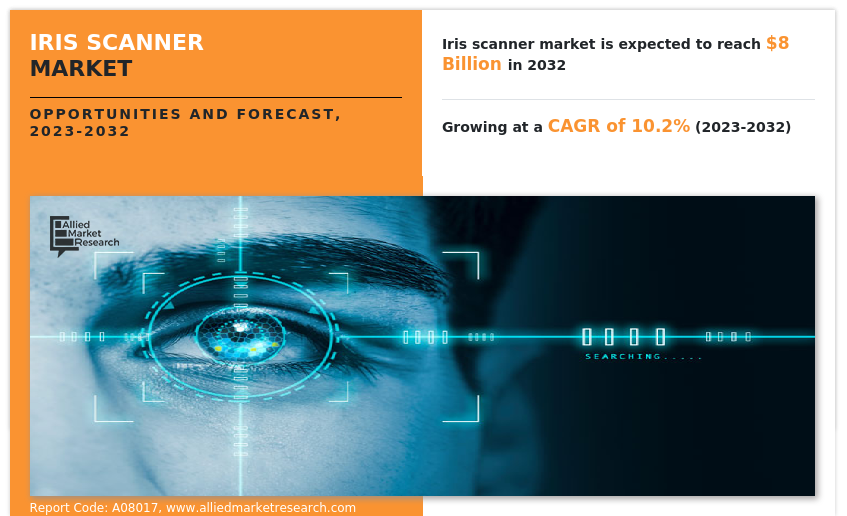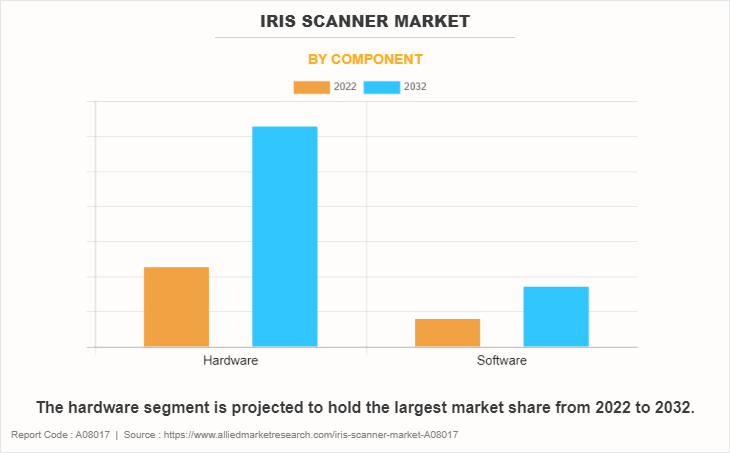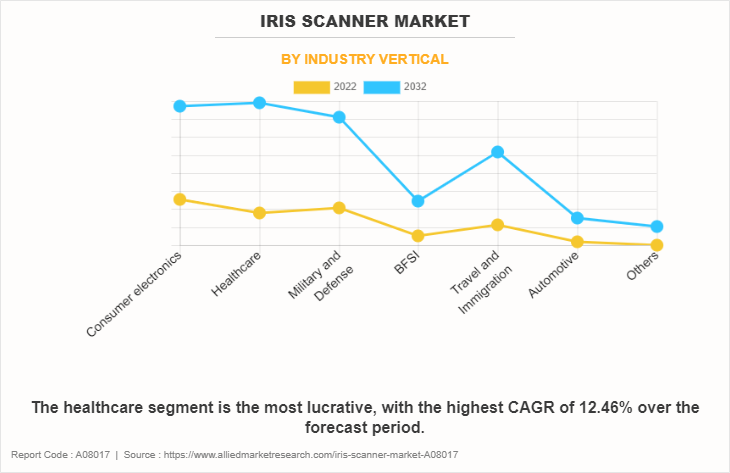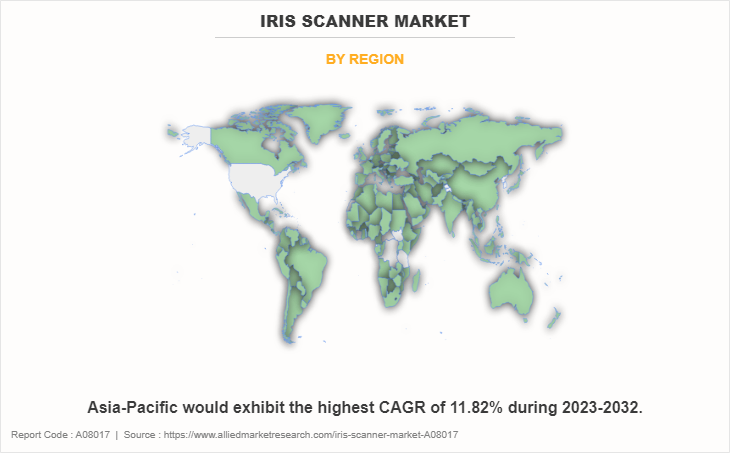IRIS Scanner Market Research, 2032
The global iris scanner market was valued at $3.1 billion in 2022, and is projected to reach $8 billion by 2032, growing at a CAGR of 10.2% from 2023 to 2032.
An iris scanner is a biometric device that identifies and authenticates individuals on the basis of unique patterns found in their irises, which are the colored parts of the eyes surrounding the pupils. This biometric authentication method involves capturing and analyzing the iris patterns using a specialized device.
The iris scanner works on an automated method of using visible and near-infrared light to take a high contrast image of one or both irises. An iris scanner uses mathematical pattern recognition techniques to take images of unique patterns of IRIS, which are analyzed to extract a pattern that encodes information in the iris. Iris scanners are dependable, accurate, and user friendly for any kind of scanning project. The iris scanner helps to maintain hygiene as it is able to take images without any contact with the subject’s body.
Iris scanners are easy-to-use, offer fast response, and the biometric authentication technology used in them is highly secure & difficult to forge. They are used in the smartphone industry for biometric authentication, such as in Samsung Galaxy S8, in the defense sector at borders to immediately identify & grant faster access to civilians & commodities, and in the BFSI sector for faster customer identification. Thus, owing to these factors and high demand from the government for several projects and private sectors, the market is expected to grow considerably in the coming years.

Segment Overview
The iris scanner market is segmented into Component and Industry Vertical.

In terms of components in the market, the Hardware segment significantly led the market in 2022.

In terms of industry verticals in the market, the consumer electronics segment notably held the largest market share in 2022.

By region, in 2022, North America emerged as the foremost revenue-generating region in the market.
Country-wise, the U.S. has acquired a prime iris scanner market share in the North American region during the forecast period of 2023-2032. This dominant position is underpinned by several factors. The U.S. is home to numerous of leading companies in the iris scanner industry, propelling growth and innovation in the sector. The country's concentrated focus on bolstering security across various sectors, including government and military, is driving the demand for advanced identification technologies like iris scanners. Additionally, escalating concerns regarding cybercrime and cyber threats are motivating the adoption of robust, biometric security solutions. The ongoing advancements and heavy investments in iris recognition technologies further reinforce the U.S.'s predominant stance in the market. The government's initiatives, such as incorporating iris recognition systems in national security and identification programs, further augment the market expansion in the country, promising sustained growth in the coming years.
In Europe, the UK has solidified its position as a dominant player in the iris scanner market in terms of revenue share in 2022, and this trend is projected to persist throughout the forecast period. This noteworthy standing can be attributed to the UK’s strategic emphasis on enhancing national security and identity verification systems. The country's commitment to investing in advanced technological infrastructures propels the growth and integration of iris recognition technologies across various sectors including government, defense, and healthcare. Additionally, the UK government’s initiatives and policies that mandate the use of secure and efficient biometric systems have further expedited the adoption of iris scanners. The heightened awareness regarding the importance of robust security systems and the UK's continuous drive for technological innovation play a crucial role in maintaining its leadership in the European iris scanner market.
In the Asia-Pacific region, China is expected to become a big market for the iris scanner industry. This growth is mainly because China is using advanced biometric technologies in many areas like government, travel, immigration, and consumer electronics. As a major center for global electronics manufacturers, China's rich supply of important rare-earth metals and its lower labor costs make it an ideal place for industries that use a lot of iris recognition parts. Also, the Chinese government is investing a lot in infrastructure projects like railways, airports, and ports. This has increased the need for modern security systems, including iris scanners. All these factors, along with China's continuous technological advancements and efforts to improve national security and identification systems, are helping to grow the country's iris scanner market.
In the LAMEA region, Latin America's commanding hold on the iris scanner market share in terms of revenue in 2022 can be attributed to a collection of factors. A significant driving force is the robust adoption of advanced security and identification systems by the region’s growing financial sector to safeguard transactions and customer data. Latin American countries, focused on strengthening security infrastructure, are increasingly integrating iris scanning technologies at critical points, including airports and border control facilities, following global trends in prioritizing security. Additionally, government initiatives promoting the adoption of advanced biometric technologies for identification and security purposes have played a vital role in propelling the market. The Integration of these factors has solidified Latin America's dominance in the iris scanner industry within the LAMEA region.
The rise in concerns about security and identity theft is a strong factor driving the market expansion. In a time where personal and business data face growing threats, there is a heightened demand for strong authentication methods. Iris scanning technology shines as a highly secure and precise way to identify individuals. Its unique features and resistance to fraud make it appealing across various sectors such as finance, healthcare, and government, where protecting sensitive information is crucial. As security concerns persist and change, the demand for iris scanner solutions continues to rise. This is pushing the market forward as organizations look for advanced ways to safeguard their assets and data. In addition, the need for security has increased due to global urbanization and factors such as rise in criminal, cyberattacks, and fraudulent activities.
However, the iris scanner market growth is hindered by various challenges, with cost being a prominent issue. Iris recognition systems are often relatively expensive, which compels users to seek more budget-friendly alternatives. This cost factor has significantly impeded market expansion, as it limits the accessibility of iris recognition technology and slows down its adoption rate. Many individuals and organizations opt for cheaper alternatives due to these cost constraints, contributing to the sluggish growth of the market.
Despite this restraint, the rise of IoT and smart city initiatives presents promising opportunities for the integration of iris scanning technology across diverse applications. In smart homes, iris scanning enhances security by providing reliable access control and authentication, ensuring only authorized individuals gain entry. In smart offices, it streamlines access to secure areas and bolster cybersecurity measures. Furthermore, in urban security systems, iris scanning provides strong identification tools for law enforcement and public safety, making cities safer and more efficient.
Top Impacting Factors
The increased adoption of iris scanners by government organizations has become a significant driver for the iris scanner market. Government agencies, such as the FBI, have integrated iris scanning technology into their identification and authentication systems, enhancing their reliability. Furthermore, the market is expected to expand through new agreements and contracts with governmental bodies. However, the market faces competition from other biometric technologies such as fingerprint, facial recognition, and voice recognition, posing a significant challenge for the market. On the bright side, the adoption of iris scanning in border control and travel operations presents a significant iris scanner market opportunity, offering swift and highly secure identity verification for international travelers and beyond.
Competitive Analysis
The Iris scanner market outlook report highlights the highly competitive nature of the market, owing to the strong presence of existing vendors. Vendors with extensive technical and financial resources are expected to gain a competitive advantage over their counterparts by effectively addressing market demands. The competitive environment in this market is expected to increase as partnerships, product launches, contracts, brandings, expansions, and acquisitions strategies adopted by key vendors increase. Competitive analysis and profiles of the major Iris scanner market players that have been provided in the report include DERMALOG Identification Systems GmbH, M2SYS Technology, IrisGuard Ltd., ams-OSRAM AG., EyeLock LLC., Princeton Identity, CMITech Company, Ltd., HID Global Corporation, Thales Group, and Iris ID, Inc.
Key Developments/ Strategies
According to the latest Iris scanner market forecast, Iris ID, Inc., Thales Group, ams-OSRAM AG., EyeLock LLC., and IrisGuard Ltd. are the top players in the market. Top market players have adopted various strategies, such as partnerships, product launches, contracts, brandings, expansions, and acquisitions to expand their foothold in the Iris scanner market.
In January 2023, Iris ID Systems, Inc. and Diyar United, a prominent information and communication technology company in the Middle East, have partnered to demonstrate the eService Kiosk integrated with Iris ID's new frictionless IrisBar solution. This fully integrated kiosk is used in eGovernment services for registration and verification at airports for immigration and passenger check-in, as a gate pass within the oil & gas industry, in the FinTech industry, as well as for National ID programs.
In May 2023, IrisGuard and NassWallet announced a partnership with the integration and deployment of the IrisGuard EyePay iris enabled smartphone, EyeCloud platform with NassWallet’s mobile wallet service. The integration enables a regular verified disbursement of humanitarian cash assistance, provided by the United Nations High Commissioner for Refugees (UNHCR) to over 280,000 refugees who have fled to Iraq due to neighbouring conflicts.
In March 2022, EyeLock LLC, launched NanoFace facial recognition solution. While EyeLock has traditionally focused on iris recognition, NanoFace from EyeLock delivers ultra-high accuracy, authentication speeds under one second, and operating distance of up to six feet. NanoFace is one of the most advanced and affordable facial biometric solutions available today, and it has consistently ranked at the top in tests conducted by the National Institute of Standards and Technology.
Key Benefits for Stakeholders
This study comprises analytical depiction of the Iris scanner market size along with the current trends and future estimations to depict the imminent investment pockets.
The overall Iris scanner market analysis is determined to understand the profitable trends to gain a stronger foothold.
The report presents information related to key drivers, restraints, and opportunities with a detailed impact analysis.
The Iris scanner market forecast is quantitatively analyzed from 2022 to 2032 to benchmark the financial competency.
The Porter’s five forces analysis illustrates the potency of the buyers and suppliers in the Iris scanner market.
The report includes the share of key vendors and Iris scanner market trends.
IRIS Scanner Market Report Highlights
| Aspects | Details |
| Market Size By 2032 | USD 8 billion |
| Growth Rate | CAGR of 10.2% |
| Forecast period | 2022 - 2032 |
| Report Pages | 271 |
| By Component |
|
| By Industry Vertical |
|
| By Region |
|
| Key Market Players | M2SYS Technology, EyeLock LLC., ams-OSRAM AG, Iris ID, Inc., Thales Group, DERMALOG Identification Systems GmbH, Princeton Identity, CMITech Company, Ltd., HID Global Corporation, IrisGuard Ltd. |
Analyst Review
The iris scanner market is projected to experience significant growth during the forecast period. First and foremost, one of the driving forces behind the anticipated growth is the ever-increasing importance of security and authentication in both consumer & business applications. With the proliferation of digital technology, the need for robust and reliable biometric solutions has become paramount. Iris recognition technology offers a highly secure and accurate means of identity verification, making it particularly appealing for a wide range of applications, including access control, mobile device security, and financial transactions. As cyber threats continue to evolve, businesses and consumers alike seek more advanced methods to protect sensitive information, hence driving the demand for iris scanners.?
Furthermore, the integration of iris recognition technology into a diverse set of industries contributes significantly to its growth. For instance, in the healthcare sector, iris scanners are employed for patient identification, ensuring the right treatment is administered to the right person, reducing medical errors and enhancing overall patient safety. In the financial sector, major banks deploy iris recognition at ATMs and for online banking services, providing customers with a secure and convenient way to access their accounts. The adoption of iris scanners is also seen in government applications, such as border control and national identification programs, where accuracy and reliability are essential.?
Other crucial factors driving the market growth are the ongoing technological advancements in iris recognition. These advancements include improvements in image capturing and processing, as well as in developing more compact and affordable hardware. This makes iris scanners more accessible to a broader range of businesses and consumers, further fueling adoption.?
Some of the key players profiled in the study include DERMALOG Identification Systems GmbH, M2SYS Technology, IrisGuard Ltd., ams-OSRAM AG., EyeLock LLC., Princeton Identity, CMITech Company, Ltd., HID Global Corporation, Thales Group, and Iris ID, Inc. These players have adopted various strategies to increase their market penetration and strengthen their position in the Iris scanner industry.??
North America was the largest regional market for IRIS Scanner in 2022.
The industry size of IRIS Scanner is estimated to be $3,046.65 million in 2022.
Security is the leading application of IRIS Scanner Market.
Iris ID, Inc., Thales Group, ams-OSRAM AG., EyeLock LLC., and IrisGuard Ltd. are the top companies to hold the market share in IRIS Scanner.
Upcoming trends in the global iris scanner market include the integration of iris scanning technology with blockchain and the increasing use of this technology in mobile devices for enhanced security.
Loading Table Of Content...
Loading Research Methodology...


